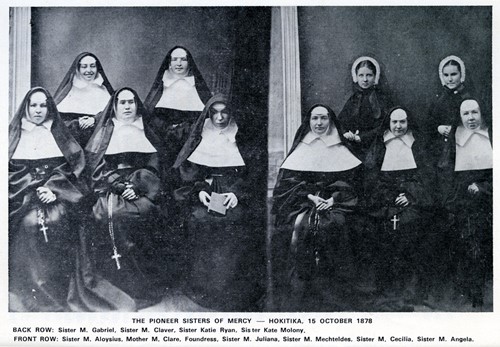A Journey of Faith
In 1878 eight nuns and two postulants left their homes in Ireland for a journey to Hokitika to establish the Sisters of Mercy Convent and Schools. This story captures The Sisters of Mercy’s journey and early days in Hokitika.

The Sisters of Mercy, #14300
The Museum holds a transcript of the diary written by one of the Sisters of Mercy nuns who travelled from Ireland to Hokitika to help found the St Columbkille’s Convent of Mercy in Sewell Street in October 1878. The following is a brief synopsis of this journey which took 85 days to complete.
The Sisters volunteered to make the journey to help fulfill the dream of parish priest Father Philip Martin whose ambition was to establish ‘a Religious Community to minister to the poor, the sick and the ignorant.’
Mother Mary Cecilia Benbow – with the approval of Pope Pius IX - travelled to England and Ireland in 1877 to meet the Sisters and to raise funds for the NZ mission. On her visit to St Xavier’s Convent Ennis, County Clare she located ‘a generous band of … Sisters of Mercy who [were prepared to] bravely bid farewell to the land they loved so well and set out for the unknown distant islands for New Zealand’.
The eight nuns and two postulants boarded the steamer S.S. Garonne’ on the 1st August in Plymouth, and by 4pm were starting to feel the effects of the ships “roiling motion.”
The next day, conditions were good enough for athletic sports to be held on deck, but this was soon curtailed as sea sickness set in. To ease their discomfort, the Sisters reclined on loungers and listened to the sounds of psalms sung to the accompaniment of a piano which had been hauled up on deck.
Five days into the voyage, their luggage was brought up on deck and they retrieved their needlework, pleased at last to have something to occupy them. They also visited the Steerage passengers “where there are a great many Germans, French, Scottish and some Irish”. On the night of the 12th of August they watched an eclipse of the moon, and saw the Southern Cross for the first time.
At the end of the third week, the Coast of Africa came into view. The ship anchored in Table Bay and Cape Town could be seen at the foot of Table Mountain. The sisters were delighted to be able to spend a day ashore. They were welcomed at the Cape Town Dominican Convent by a community of Irish Sisters, and experienced “unspeakable happiness [at] hearing Mass once again and receiving the Holy Communion.”
The Garonne reached Melbourne on September 18th. Here they disembarked and spent a happy week touring the city.
On 25th September they boarded the S.S. Albion bound for New Zealand, noted as “the land of our adoption”. The weather was not kind from the time they left, and four days later they experienced a fearful and sleepless night where many thought they were going down. Thankfully, the next day the sun was shining and land was sighted - “grand scenery – snowcapped summits of the Southern Alps rear their giant heads to the clouds.”
Going ashore on 30th September at Port Chalmers, the group of nuns were welcomed by Dr Moran, Bishop of Dunedin, before sailing on to Lyttleton where they met some local Irish and old inhabitants of Hokitika. In Wellington on the 3rd October they met the Wellington Sisters of Mercy and participated in a Mass at the Cathedral, before being guided by a procession of school children to the Convent which had been gaily decorated for the occasion.
Sailing down the West Coast, they finally reached Hokitika at 11 am on 15th October, but bad weather prevented the Tararua from crossing the bar, forcing them to anchor offshore. A huge crowd assembled at the wharf to greet the Sisters, but after long delays and much rain, the official welcoming ceremony was postponed. After a 12 hour wait, the Sisters boarded a tender and made their way in the dark to the wharf. They were escorted on-shore by Mr Cleary the Governor of the Hokitika Goal, and Mr Burke - the Secretary of Catholic Affairs. Three waiting coaches took them to Mulligans cottage (now 100 Stafford St) - a temporary residence where they received refreshments and met members of the Catholic Community. Here they stayed until the new Convent was completed in January 1879.
A few days after their arrival, the Sisters took charge of the girls’ school of 105 pupils. They reported that in general the children ‘were very intelligent’.
During the next 100 years, the Sisters of Mercy ran St Mary’s Primary School, and established a High School with boarding facilities. They also undertook important pastoral work to ‘the sick, the poor and the imprisoned’. Over time the pioneer Sisters were involved in the establishment of schools in Greymouth, Rimu, Kaniere, Ross, and Christchurch.
St Mary’s High School closed on 2nd December 1973. Changes occurring within the Catholic Church, increasing operational costs, and declining rolls were the main reasons for the closure. In October 1975 the Sisters moved out of the old Convent and a week of celebrations were held to commemorate its closing. Over 1000 people travelled from all over New Zealand to attend this event. The remaining sisters continued to teach at the Primary School, while others focused their efforts on religious education and pastoral work. The St Mary’s Primary school continues to operate in Hokitika today.
